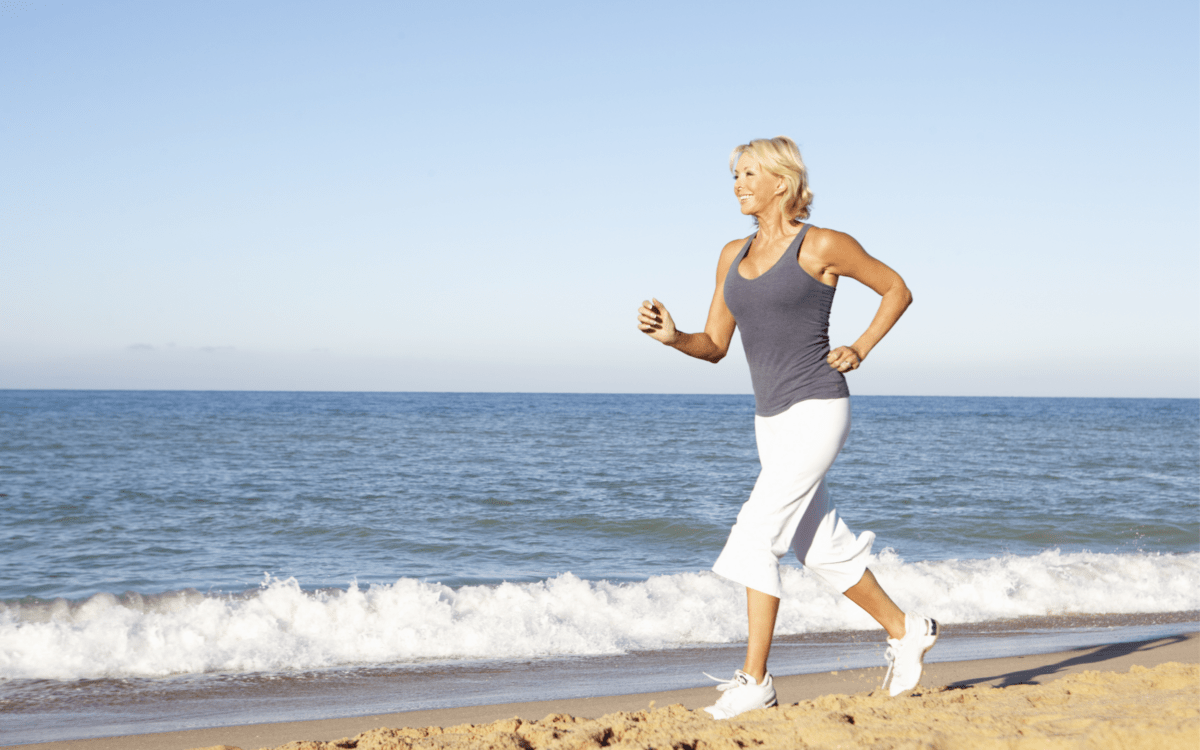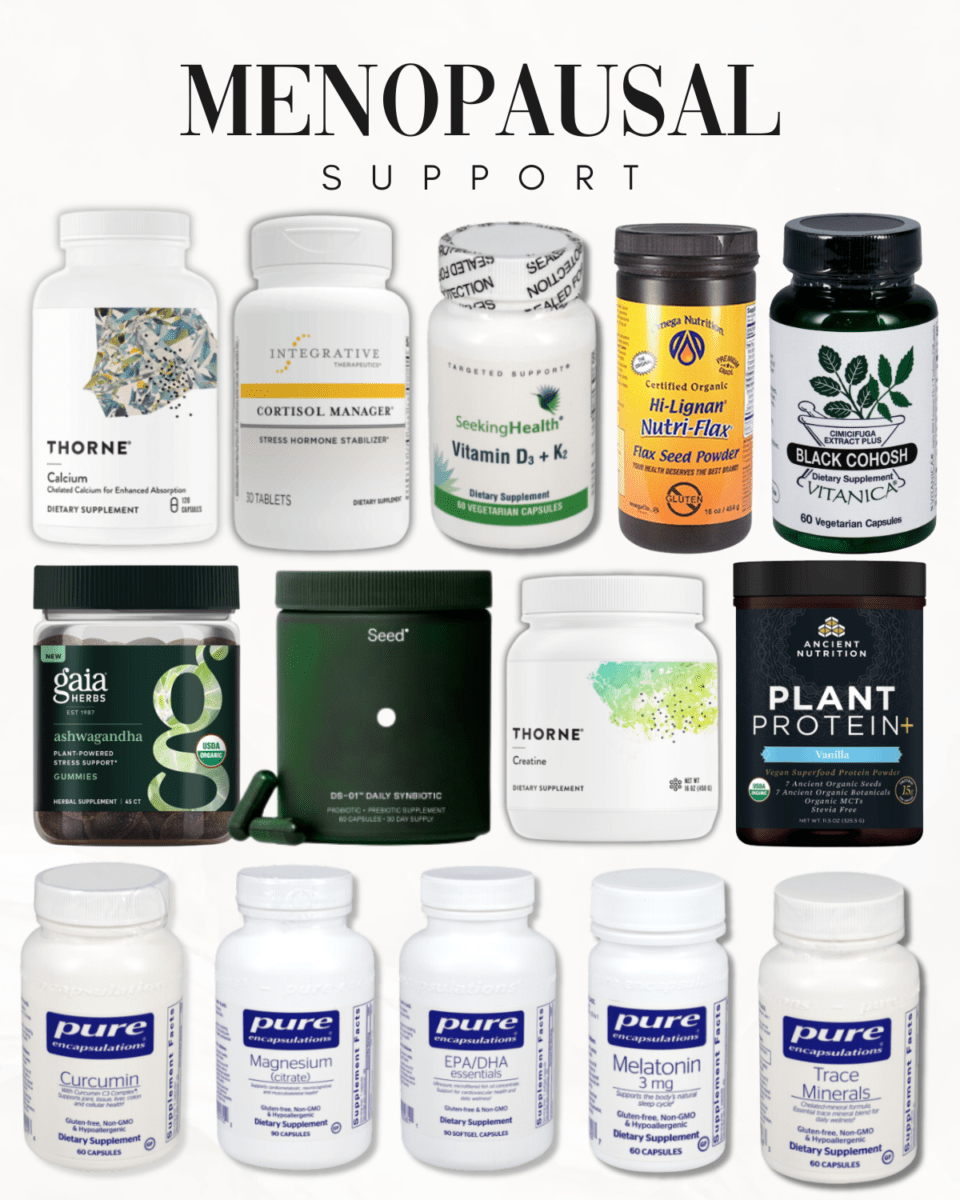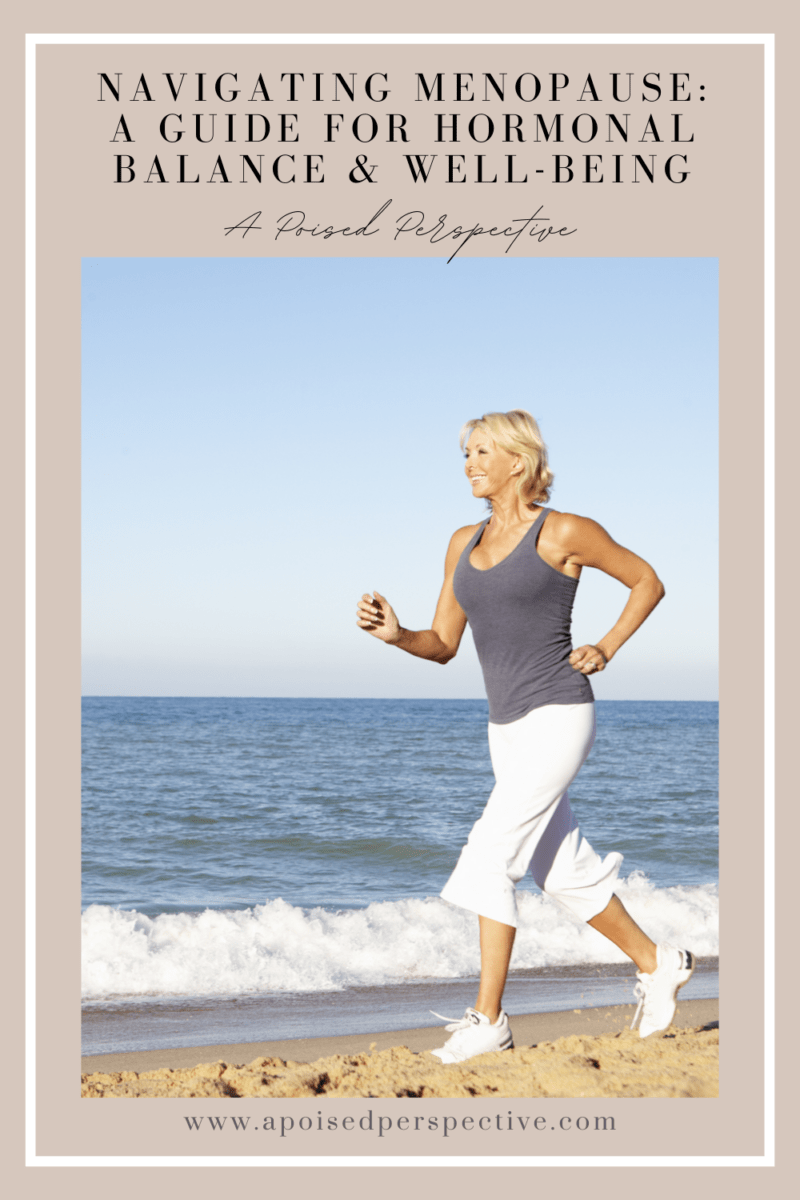
Navigating menopause can be a transformative journey filled with both challenges and opportunities for growth. As women transition through this natural phase of life, they often encounter a range of hormonal fluctuations and physical changes that can impact their overall health and well-being.
In this blog post, we’ll explore a holistic approach to navigating menopause, focusing on the importance of nutrition and fitness in supporting hormone balance, managing symptoms, and promoting overall wellness. From dietary strategies to exercise routines, we’ll delve into practical tips and evidence-based recommendations to help women thrive during this transitional phase. Whether you’re experiencing hot flashes, mood swings, or sleep disturbances, or simply seeking to optimize your health during menopause, this nutrition and fitness protocol is designed to empower you with the knowledge and tools you need to navigate menopause with confidence and vitality.
While I am not personally in menopause yet, this blog post was highly requested after last month’s blog post on Navigating Perimenopause. Therefore this blog post will come from my professional point of view while heavily relying on the research, tips and tricks from my two favorite female hormone specialists.
What is Menopause?
Menopause typically occurs between the ages of 45 and 55, with the average age being around 51 in most women. However, the age at which menopause occurs can vary widely among individuals. Some women may experience menopause earlier or later than the average age, with factors such as genetics, lifestyle, and medical history playing a role in the timing of menopause.
According to Mayo Clinic: Menopause is the time that marks the end of your menstrual cycles. It’s diagnosed after you’ve gone 12 months without a menstrual period.
In the months or years leading up to menopause (perimenopause), you might experience these signs and symptoms:
- Irregular periods
- Vaginal dryness
- Hot flashes
- Chills
- Night sweats
- Sleep Problems
- Mood changes
- Weight gain and slowed metabolism
- Thinning hair and dry skin
- Loss of breast fullness
Signs and symptoms, including changes in menstruation can vary among women. Most likely, you’ll experience some irregularity in your periods before they end.
I’ve followed Dr. Sarah Gottfried, author of “The Hormone Cure” & “The Hormone Reset Diet,” for several years. I consider her and my doctor, Dr. Lida Aghdam to be two of the top specialists when it comes to women’s health and hormones.
Read what Dr. Sarah Gottfried has to say about female hormones during menopause in this interview. You can find more on this in her book, “The Hormone Cure.”
“Low estrogen may be a sign of approaching menopause which can add mild depression to the mix, along with wrinkles, poor memory, hot flashes/night sweats, vaginal dryness, droopy breasts, achy joints, and more sun damage, especially on the chest and shoulders. In your forties, gene variants, like the short serotonin transporter gene (5-HTTLPR, or SLC6A4), can cause you to feel more stress, anxiety, and depression as estrogen drops.
Women in menopause commonly have low cortisol during the day, which may make them feel tired, and high cortisol at night, which may make them worry about everything from the stock market to whether or not their kids will get decent jobs.
At any time, a woman can experience low thyroid function, but this is more common after age fifty. Thyroid-related symptoms include lethargy, weight gain, loss of the outer third of the eyebrows, dry skin, strawlike hair that tangles easily, thin/brittle fingernails, fluid retention, high cholesterol, constipation, decreased sweating, cold hands and feet, and cold sensitivity (i.e., skiing sounds miserable but a trip to Hawaii sounds just right).
Testosterone starts declining 1 to 2 percent per year starting in your thirties, and it may lead to decreased confidence, feelings of helplessness, low or no sex drive, loss of muscle mass or less of a muscle response to resistance training, and loss of pubic hair and clitoral size. No bueno—but there is help.”
What is the difference between Perimenopause and Menopause?
Perimenopause
Timing: Most women transition to perimenopause between the ages of 35 – 45, but can vary.
Hormonal Changes: During perimenopause, estrogen levels fluctuate, and the ovaries gradually produce less estrogen over time. These hormonal changes can lead to irregular menstrual cycles and various symptoms such as hot flashes, night sweats, mood swings, and changes in libido.
Menstrual Changes: Women may experience changes in the frequency, duration, and intensity of menstrual periods. Periods may become shorter, longer, lighter, heavier, or more unpredictable.
Fertility: While fertility declines during perimenopause, it is still possible for women to become pregnant, although the chances decrease as perimenopause progresses.
Menopause
Timing: Most women reach menopause by the age of 51 and 52, but can vary.
Hormonal Changes: Estrogen levels have significantly declined by the time a woman reaches menopause, and the ovaries have largely stopped releasing eggs.
Symptoms: While some women may experience symptoms such as hot flashes, night sweats, and vaginal dryness leading up to menopause, these symptoms often diminish or resolve after menopause.
Fertility: Once a woman reaches menopause and has gone 12 consecutive months without a period, she is no longer fertile, and pregnancy is not possible without medical intervention.
Why Is It Harder for Women to Keep the Weight Off After The Age of 35?
During perimenopause and menopause, women experience hormonal fluctuations, which can contribute to several factors that make weight loss more challenging:
Loss of Muscle Mass: “Muscle mass decreases approximately 3–8% per decade after the age of 30 and this rate of decline is even higher after the age of 60.”
“As a woman gets older and enters the second phase of perimenopause, both progesterone and estrogen (specifically, estradiol) are lower. Testosterone drops too, leading to less muscle mass (dropping five pounds of muscle per decade) and rising fat mass, a dreaded combination that accelerates aging.”
Changes in Fat Distribution: Hormonal changes during perimenopause can lead to a shift in fat distribution, with more fat accumulating around the abdomen rather than the hips and thighs. Abdominal fat, in particular, is associated with an increased risk of metabolic disorders and is harder to lose.
Increased Appetite and Food Cravings: Hormonal fluctuations can also affect appetite regulation and increase cravings for high-calorie, carbohydrate-rich foods. This can lead to overeating and make it more challenging to stick to a calorie-controlled diet.
Insulin Resistance: Some women may become more insulin resistant during perimenopause, leading to higher blood sugar levels and increased fat storage, especially around the abdomen.
Stress and Sleep Disturbances: Perimenopause can be accompanied by increased stress levels and sleep disturbances, which can negatively impact metabolism, appetite regulation, and energy levels, making weight loss more difficult.
Psychological Factors: The physical changes associated with perimenopause, such as weight gain and changes in body composition, can also affect women psychologically, leading to feelings of frustration, low self-esteem, or emotional eating patterns that hinder weight loss efforts.
Overall, the combination of hormonal changes, metabolic shifts, changes in body composition, and lifestyle factors during perimenopause can make it harder for women to lose weight compared to earlier stages of life. However, adopting healthy lifestyle habits, such as regular exercise, a balanced diet, stress management, and adequate sleep, can still support weight management during this transitional phase.
How To Navigate Through Menopause
Navigating through Menopause involves understanding the changes happening in your body and implementing strategies to manage symptoms and support your overall health and well-being. Here are some tips for navigating through Menopause:
Educate Yourself: Learn about Menopause, including its symptoms, hormonal changes, and potential effects on your health. Understanding what to expect can help you feel more prepared and empowered to manage this transitional phase.
Healthy Lifestyle Habits
Regular Exercise: Incorporate regular physical activity into your routine, including aerobic exercise, strength training, and flexibility exercises. Exercise can help alleviate symptoms such as mood swings, hot flashes, and weight gain, while also supporting bone health and cardiovascular function.
Balanced Diet: Eat a balanced diet rich in fruits, vegetables, whole grains, lean proteins, and healthy fats. Avoid excessive consumption of processed foods, sugary snacks, and refined carbohydrates, which can exacerbate symptoms such as fatigue, mood swings, and weight gain.
Adequate Sleep: Prioritize quality sleep by practicing good sleep hygiene habits, such as maintaining a consistent sleep schedule, creating a relaxing bedtime routine, and creating a comfortable sleep environment. Address sleep disturbances promptly, as they can exacerbate symptoms such as irritability, fatigue, and difficulty concentrating.
Stress Management: Find effective ways to manage stress, such as mindfulness meditation, deep breathing exercises, yoga, prayer, tai chi, or spending time in nature. Chronic stress can worsen symptoms such as hot flashes, mood swings, and sleep disturbances, so it’s essential to incorporate stress-reduction techniques into your daily routine.
Hormone Therapy: Consider Hormone therapy (HT) or other medications to alleviate severe symptoms and improve quality of life. HT can help manage symptoms such as hot flashes, vaginal dryness, and mood swings, but it’s essential to weigh the potential benefits and risks and discuss them with your healthcare provider.
Lower Cortisol Levels: Lowering cortisol levels, especially when chronically elevated due to stress, is essential for overall health and well-being.
Here are some strategies to help lower cortisol levels naturally
- Stress Management Techniques
- Regular Exercise
- Adequate Sleep: 7-9 Hours
- Healthy Diet
- Limit Caffeine and Alcohol
- Mindful Eating
- Social Support
- Time Management
- Relaxation Activities
Lower Toxic Loads: Dr. Sarah Gottfried says: “We are exposed to more toxins than ever before. Endocrine disruptors are synthetic chemicals that are now rampant in plastic materials, cosmetics, cleaning supplies, and other products we use on a day-to-day basis. Endocrine disruptors interfere with the production, transportation, and metabolism of most hormones. And since these environmental toxins are almost impossible to avoid, they may be wreaking havoc on your body without your awareness. The problem is these chemicals, aptly called obesogens, have the potential to make us sick and fat.
Get this: as our exposure to endocrine disruptors has increased, so has the incidence of thyroid disease in the United States, particularly for thyroid cancer and thyroid autoimmune disease. People who showed the highest 20 percent of exposure to environmental toxins also experienced up to 10 percent more thyroid function impairment than those with the lowest 20 percent exposure.”
How to Lower Your Toxic Load
Lowering your toxic load involves minimizing exposure to harmful chemicals and toxins in your environment while supporting your body’s natural detoxification processes. Here are some strategies to help reduce your toxic load:
- Eat a Clean Diet
- Stay Hydrated
- Choose Non-Toxic Household Products
- Minimize Exposure to Environmental Toxins
- Reduce Plastic Use or choose BPA free plastics
- Support Liver Health by reducing alcohol and eating cruciferous vegetables like broccoli, cauliflower, Brussels sprouts.
- Practice Stress Management
- Get Regular Exercise
- Support Digestive Health with a fiber rich diet
Fitness Protocol for Women in Menopause
Strength Training: Focus on strength training exercises at least two to three times per week. This helps maintain muscle mass, which tends to decline with age and hormonal changes.
Cardiovascular Exercise: Incorporate aerobic activities like walking, jogging, swimming, or cycling for at least 150 minutes per week to improve heart health and manage weight.
Important Note on Cardio: If you are a cardio junky, it may be time to switch things up a bit if you’ve stopped seeing the results you used to see. Replace a couple days of cardio in your week with resistance training and you may be shocked with the results.
Important Note on High Intensity Training: While it may seem like intense exercise will get the weight off faster, too much high intensity exercise can lead to elevated levels of cortisol in the bloodstream and heightened symptoms of physical stress, even when exercise is not being performed. Since the goal is to lower cortisol levels, I do not suggest high intense exercise training every day. A couple times a week is ok to reap the benefits, but it shouldn’t be a daily occurrence. I am not personally a fan of the dark fitness studios with loud music and intense exercise classes. I loved them in my 20s and early 30’s but I think these types of classes may be doing us more harm than good as we get older. We need to see the daylight during the day to help with our circadian rhythm. Loud and intense exercise every day is not the prescription for menopausal women. We need to be working on lowering our cortisol levels, not increasing it.
Flexibility and Balance: Include flexibility and balance exercises such as yoga or Pilates to maintain joint mobility and reduce the risk of falls.
Listen to Your Body: Be mindful of any changes in energy levels, joint pain, or other symptoms. Adjust your exercise intensity and duration accordingly.
Rest and Recovery: Allow for adequate rest days between workouts to prevent overtraining and support hormonal balance.

Recommended Workout Routine For Women 50+
This specific workout routine is for women ages 50+ that want to achieve a lean and sculpted physique.
Heavy Resistance Training: (8-12 reps, 2-3 sets) – 2-4 days/week.
Lighter Resistance (low weight, high rep) or Mobility Training: – 1-2 days/week.
Cardio Training: – 1-2 days/week.
Examples:
If you work out 3 days per week.
You could lift heavy 2 days per week and do lighter resistance like body weight, bands, yoga or pilates, 1 day/week. I’d suggest zone 2 cardio a couple times per week at least as well. This could be going for a brisk walk or playing pickle ball.
If you work out 5 days per week.
You could lift heavy 3 days per week and do lighter resistance 1 day/week. I’d suggest brisk walking in zone 2 cardio a couple times per week at least as well or whatever cardio you find enjoyable.
Nutrition Protocol for Menopausal Women

Balanced Diet: Focus on a balanced diet rich in fruits, vegetables, lean proteins, whole grains, and healthy fats to support overall health and manage weight.
Calcium and Vitamin D: Ensure adequate intake of calcium and vitamin D to support bone health. Good sources include dairy products, leafy greens, fortified foods, and supplements if needed.
Omega-3 Fatty Acids: Include sources of omega-3 fatty acids such as fatty fish (salmon, mackerel, sardines), flaxseeds, chia seeds, and walnuts to support heart health and reduce inflammation.
Hydration: Stay hydrated by drinking plenty of water throughout the day, as hormonal changes may increase the risk of dehydration and affect skin health.
Limit Processed Foods: Minimize consumption of processed foods, refined sugars, and excess caffeine, which can exacerbate hormonal fluctuations and contribute to weight gain.
Natural Supplements for Menopausal Support
Here’s a list of supplements that can be helpful during menopause. It’s advised that you consult your doctor before taking any supplements, but these are supplements that Dr. Lida Aghdam and Dr. Sarah Gottfried both encourage for menopausal women. These supplements are in my Fullscript Dispensary, a dispensary for integrative nutritionist and practitioners. You’ll need to create a free account first to see the full list.
- Calcium
- Vitamin D3 + K2
- Probiotic
- Multivitamin or Trace Minerals
- Omega 3’s
- Magnesium – improves mood, sleep, exercise performance, blood sugar regulation, maintaining regular bowel movements and more.
- Curcumin – (management of oxidative and inflammatory conditions, metabolic syndrome, arthritis, anxiety, and hyperlipidemia)
- Ashwaganda – (reduces perceived stress and levels of the stress hormone cortisol)
- Protein Powder (Assist in getting adequate protein in your day to maintain muscle.)
- Creatine (If you strength train)
- Cortisol Manager – supports balanced cortisol and healthy stress response. Made up of Ashwaganda and L-Theanine.
- Black Cohosh Extract – provides relief for women who are experiencing hot flashes.
- Flaxseed – can help with night sweats as flaxseed and flaxseed oil can help balance hormones.

Middle-Aged Women are typically stressed to the max – let’s not ignore this
Perimenopause and menopause usually come around the time our children are getting older and our parents are getting older. An unusual amount of stress is put upon women during this time as we care about the ones we love and we continue to pour into them. The teen years can be challenging, aging parents and their health is a concern as well. This is just life. However, friends be sure you are taking care of your own health. Don’t let life consume you during this time. Ask for help and outsource where you can. It’s ok to say no, it’s ok to get a massage, it’s ok to care for yourself. Alot falls on the woman during these stages of life. Find something that brings you joy. Is that tennis or pickleball with friends, a fitness class, dinner or hiking with friends, or taking a timeout from life to make time for your loved-ones. Just take care, friends. Remember… you can’t pour from an empty cup. Remember that old saying, Live, Laugh, Love? Truly though.. Are you living, laughing and loving? If not… it’s time to make time for it. Life is too short.
Tools for De-Stressing
In conclusion, navigating menopause requires a multifaceted approach that encompasses nutrition, fitness, and overall self-care. By adopting a balanced diet rich in nutrient-dense foods, prioritizing regular physical activity, and incorporating stress-reduction techniques into daily life, women can support hormone balance, manage symptoms, and promote overall well-being during this transitional phase. It’s essential to listen to your body, prioritize self-care, and seek support from healthcare providers or professionals who specialize in menopause management. With the right strategies and resources in place, menopause can be embraced as a natural and empowering phase of life, allowing women to thrive with confidence and vitality. Remember, every woman’s journey through menopause is unique, so it’s important to tailor your approach to suit your individual needs and preferences. By prioritizing self-care and adopting a holistic approach to health and wellness, women can navigate menopause with grace and resilience, embracing this new chapter of life with confidence and vitality.


